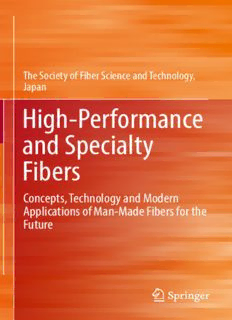
High-Performance and Specialty Fibers: Concepts, Technology and Modern Applications of Man-Made Fibers for the Future PDF
Preview High-Performance and Specialty Fibers: Concepts, Technology and Modern Applications of Man-Made Fibers for the Future
The Society of Fiber Science and Technology, Japan High-Performance and Specialty Fibers Concepts, Technology and Modern Applications of Man-Made Fibers for the Future High-Performance and Specialty Fibers ThiSisaFMBlankPage The Society of Fiber Science and Technology, Japan Editor High-Performance and Specialty Fibers Concepts, Technology and Modern Applications of Man-Made Fibers for the Future Editor TheSocietyofFiberScienceandTechnology,Japan Tokyo Japan ISBN978-4-431-55202-4 ISBN978-4-431-55203-1 (eBook) DOI10.1007/978-4-431-55203-1 LibraryofCongressControlNumber:2016943200 ©SpringerJapan2016 Thisworkissubjecttocopyright.AllrightsarereservedbythePublisher,whetherthewholeorpartof the material is concerned, specifically the rights of translation, reprinting, reuse of illustrations, recitation, broadcasting, reproduction on microfilms or in any other physical way, and transmission or information storage and retrieval, electronic adaptation, computer software, or by similar or dissimilarmethodologynowknownorhereafterdeveloped. The use of general descriptive names, registered names, trademarks, service marks, etc. in this publicationdoesnotimply,evenintheabsenceofaspecificstatement,thatsuchnamesareexempt fromtherelevantprotectivelawsandregulationsandthereforefreeforgeneraluse. Thepublisher,theauthorsandtheeditorsaresafetoassumethattheadviceandinformationinthis book are believed to be true and accurate at the date of publication. Neither the publisher nor the authors or the editors give a warranty, express or implied, with respect to the material contained hereinorforanyerrorsoromissionsthatmayhavebeenmade. Printedonacid-freepaper ThisSpringerimprintispublishedbySpringerNature TheregisteredcompanyisSpringerJapanKK Preface The Society of Fiber Science and Technology, Japan (SFSTJ) was established in 1943 by merging the Cellulose Association (founded in 1924) and the Society of Industrial Fiber Technology (founded in 1935). Since then, SFSTJ has been con- tributingnotonlytoresearchandeducationonfiberscienceandtechnologybutalso to the development of the fiber and textile industries. In December 2013, SFSTJ celebrated its 70th anniversary and held a commemorative ceremony for the anniversary on September 29, 2014. The ceremony was followed by the Interna- tionalSymposiumforFiberScienceandTechnology(ISF2014),lookingbackatits previous activities and looking ahead to the fiber science and technology of the future. For this purpose, many prominent scientists and important leaders from government, academia, and industry around the world were invited. In addition, SFSTJ made plans to publish this book commemorating the 70th anniversary by compilingthewholeoffiberscienceandtechnologythathavebeendevelopedthus far. In particular, new technologies for manmade fibers that have recently been industrializedinJapanarehighlightedtoshedlightonthefuturetechnologiesthat willbeneededinthefiberandtextileindustryofthiscentury. Manmade fibers have a long history, and their current developments ought to have their own historical backgrounds. We therefore succeeded in reviewing the historical origins of the newly developed fibers in addition to the concepts and processes for their development, as well as their key technologies and excellent characteristics. Recently, the production center of many low-cost manmade fibers such as polyester has shifted from Japan to China after the past drift from the Westerncountries,includingtheUnitedStates,toJapan.Suchtransitionhasforced Japanesefibercompaniestochangetheirbusinessstrategyfrommassproductionto small-sizeproductionofhigh-quality,high-performancefibers.Currently,manyof the specialty fibers are industrialized in Japan. For example, Zylon and Dyneema from Toyobo are the strongest organic and super high-elastic-modulus fibers, respectively. Technora from Teijin and Vectran from Kuraray are high-strength fibers. Torayca is the most famous carbon fiber produced by Toray. These fibers havingoutstandingpropertiesconstitutethemainsubjectsofthisbook. v vi Preface Weareproud tohavebeenabletoinvitetheinventors orspecialistsfromboth industryandacademiaasauthorswhowriteaboutthevariousfibers.Theydescribe indetailthedesignconceptsandkeytechnologiesusedfortherespectivemanmade fibers in the chapters for which they were responsible. These chapters have been effectivelycompiled intoabookthatcan beused notonly asagoodtextbook for universityteachersandstudentstolearnbasicconceptsofmodernfibers,butalsoas a review or a reference book for researchers in academic organizations and com- panies to overview the recent statuses of manmade fibers, particularly specialty fibersthathavebeendevelopedinJapantodate.Thisbookisthereforepresentedas arecordoftheoutcomeofimportantresearchbyJapanesescientistsandengineers whohavebeeninvolvedinthedevelopmentofmanmadefibersinJapan.Italsohas the distinction of being the first English book authorized by The Society of Fiber ScienceandTechnology,Japan. In the initial publication plan for this book, Springer explained to us that they now publish not only printed books but also ebooks, which readers can access throughtheInternet.Thison-linepublishingsystemisconvenientforreadersinthat thebookstheyneedarereadilyavailablewhetherintheofficeorathome.Readers whoareinterestedinhavingahardcopyofabookcanorderaprintedversionwhich will be mailed to them. On-line publications in principle keep on sailing forever, and no book ever goes “out of print”. In other words, if a book is continuously revised,itwillnotlosecontemporary valueasareference bookandasadataand information source. This feature is especially attractive for authors and editors although continued revision may not always be easy. Therefore, revisions must be made in an organized manner from generation to generation by leaving it to scientific societies or organizations where the most capable authors can be nomi- natedfromamongmanyeminentmembersatthetimeofrevisioninordertoupdate the descriptions and data. Based on this concept, SFSTJ decided to edit this book andtocontinueitsrevisiontomaintainthecontemporaryqualityofthebookinthe future.Thepresentvolumeisthereforetobeconsideredonlyafirstversionleading to a comprehensive treatise on fiber science and technology that will be accom- plishedafterseveralrevisionsteps. Here, we express our deep appreciation to the many authors who devoted themselves to writing their respective chapters, sacrificing their valuable time. We also acknowledge the section directors who arranged the important sections byinvitingexcellentauthorsandsometimeseditingthemanuscriptssubmitted. Finally, Ms. Taeko Sato and Dr. Shin’ichi Koizumi at Springer Japan are gratefully acknowledged for their valuable support for the publication of this book. Without their initial proposal and their follow-up arrangements, this book wouldnothaveappeared. Preface vii OnbehalfofSFSTJ,theassociateeditorshopethatallreadersenjoythisbook, whichwebelieveishighlyinterestingandinstructive. Managers YoshiharuKimura(Chief) EmeritusProfessor,KyotoInstituteofTechnology AkiraTsuchida(Sub) Professor,GifuUniversity KanameKatsuraya(Sub) Professor,WayoWomen’sUniversity Editor TheSocietyofFiberScienceandTechnology,Japan ThiSisaFMBlankPage List of the Editorial Staff Editor TheSocietyofFiberScienceandTechnology,Japan Managers YoshiharuKimura(Chief),AkiraTsuchida(Sub),KanameKatsuraya(Sub) SectionDirectors PartI:TakeshiKikutani PartII:KazuyukiYabuki(Chief),KohjiTashiro(Sub),HirokiMurase(Sub) PartIII:TogiSuzuki PartIV:AkihikoTanioka PartV:MakotoEndo PartVI:MasatsuguMochizuki PartVII:KanameKatsuraya AdvisoryBrains MasatsuguMochizuki,HirokiMurase Superviser TsuneoOkubo Authors PartI Chapter1:ToshijiKanayaandKeisukeKaji Chapter2:KohjiTashiro Chapter3:TakeshiKikutani Chapter4:MasatoshiAoyamaandYoichiroTanaka ix
Description: